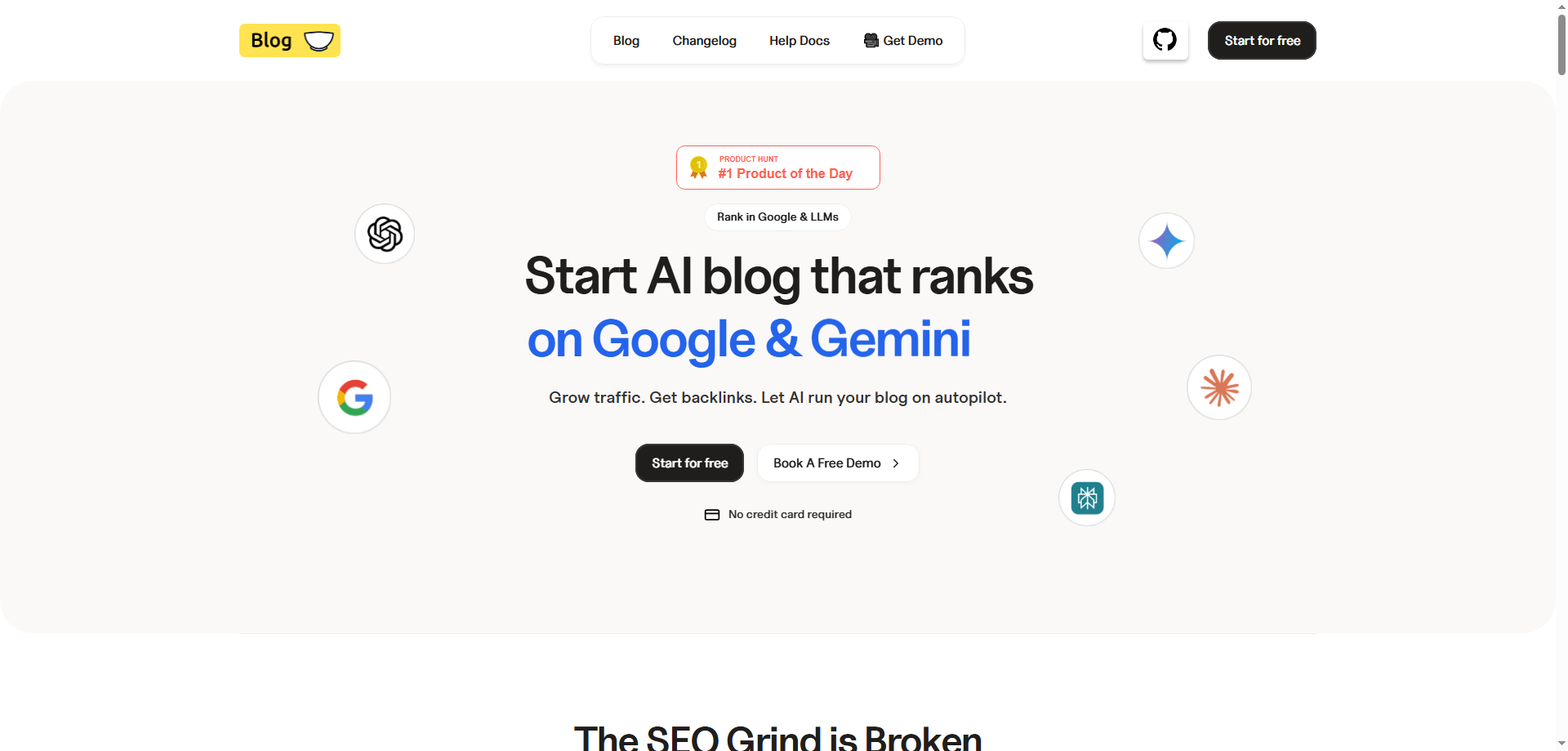1. Seeing BlogBowl from a Creative Perspective
If you’ve ever felt like managing a blog eats up your creative energy, BlogBowl feels like a breath of fresh digital air. I see it as a creative partner, not just a tool. Imagine typing in a few keywords — “AI marketing trends,” “startup storytelling,” or “eco-friendly design” — and within minutes, your screen fills with a full-fledged, SEO-optimized article that sounds eerily human.
BlogBowl doesn’t just churn out generic text; it creates context. Each article it generates feels like it understands tone, flow, and intent. It automatically includes images, videos, charts, and even cited data, turning plain ideas into full-blown multimedia stories.
What I find most creative about BlogBowl is how it integrates AI writing with artistic design. It doesn’t replace creativity — it extends it. I can focus on my brand’s voice, while it handles the mechanics: structure, SEO, and publishing. It’s like having a team of writers, editors, and SEO experts working silently behind my laptop.
As someone who spends hours brainstorming blog topics, I see BlogBowl as an idea amplifier — it takes raw creativity and polishes it into publish-ready brilliance.
2. The Disruptive Angle: Can BlogBowl Replace Human Writers?
Here’s the million-dollar question — is BlogBowl a threat or a tool? From what I’ve experienced, it’s a bit of both.
BlogBowl disrupts traditional content workflows by doing what usually takes a human team — research, writing, formatting, SEO optimization, and publishing — all in one go. I can literally connect it to my blog, feed it a few keywords, and within five minutes, I have a professional, fully formatted article online.
That’s not just automation — that’s reinvention.
Can it replace human writers entirely? I’d say not yet. BlogBowl writes impressively natural content, but it still lacks that unpredictable human nuance — the kind of emotion or humor you can’t program. However, for businesses and marketers who need volume, speed, and consistency, BlogBowl could easily replace 80% of their manual content creation process.
It’s not about replacing creativity — it’s about scaling it. Traditional blogging tools help you write faster; BlogBowl helps you publish smarter.
This is a shift from “create content manually” to “orchestrate an AI-powered content system.” In the same way Netflix changed how we consume media, BlogBowl is changing how we create and distribute blog content.
3. Understanding User Demand: How Accepting Are People Toward BlogBowl?
From my observation, people are more than ready for this. The modern content creator — whether an indie developer, marketer, or small business owner — is overwhelmed. Managing SEO, writing engaging content, keeping up with Google’s algorithms, and promoting posts is exhausting.
BlogBowl hits the sweet spot between need and convenience.
Here’s why I think users are embracing it:
- It’s keyword-driven — meaning it directly aligns with how people already think about SEO.
- It offers end-to-end automation, from writing to publishing, saving massive time.
- It produces Google-optimized and AI-compatible content (yes, ChatGPT and Claude pick it up easily).
- It feels human — the tone, structure, and embedded media give a sense of authenticity.
The demand for tools like BlogBowl has exploded in the past two years. Marketers are seeking faster ways to create long-form content that ranks. Developers and entrepreneurs are turning to AI assistants to keep their blogs alive while they focus on building products.
In short, BlogBowl doesn’t just fill a gap — it defines a new category.
It’s not merely a blogging tool; it’s a blog autopilot system.
When users realize they can grow organic traffic, publish professional posts, and maintain consistency without a content team, acceptance becomes inevitable.
4. One-Year Survival Score: ⭐️⭐️⭐️⭐️☆ (4/5)
Now let’s get real. Will BlogBowl survive and thrive over the next year? I’m betting yes, and here’s why — but also where the risks lie.
⭐️ The Opportunities
- Market Growth – The AI content creation industry is booming. Everyone, from solopreneurs to startups, needs consistent content. BlogBowl is perfectly positioned here.
- Feature Depth – The platform already integrates SEO templates, analytics, and newsletter tools, making it more than a writing bot. It’s a full content ecosystem.
- Time Efficiency – Users love automation that feels intelligent. With five-minute setup and autopublishing, BlogBowl saves hours every week.
- SEO-Driven Innovation – Its optimization for Google, ChatGPT, and Claude means BlogBowl rides the wave of evolving search and AI indexing systems.
⚠️ The Risks
- AI Fatigue – With hundreds of AI content tools launching monthly, user attention is short. BlogBowl needs strong branding to stand out.
- Quality Control – As AI evolves, users will demand more than just “human-like” writing. Emotional depth, storytelling, and voice will separate winners from clones.
- Dependence on Algorithms – If Google tightens its grip on AI-generated content detection, tools like BlogBowl could face visibility challenges.
- User Trust – Many creators still hesitate to hand over full creative control to AI. Building trust will be key.
Overall, I’d rate BlogBowl’s one-year survival a solid 4 out of 5 stars. It has real product-market fit, rapid onboarding, and clear differentiation. If it continues improving content authenticity and transparency, it’ll thrive.
Final Thoughts: Why I’m Betting on BlogBowl
From a personal standpoint, I see BlogBowl as the next step in digital publishing. It’s the tool that finally bridges the gap between AI efficiency and human creativity.
When I use it, I feel less like I’m “automating my blog” and more like I’m collaborating with an intelligent co-writer. I can focus on my vision — the story, the message, the strategy — while BlogBowl handles the grind: formatting, SEO, and publishing.
If traditional blogging was about persistence, BlogBowl blogging is about precision.
So yes, I’d give BlogBowl a strong endorsement. It’s creative, disruptive, and user-centric. And if it keeps evolving, it won’t just survive — it’ll redefine how we write, rank, and share ideas in the age of AI.









